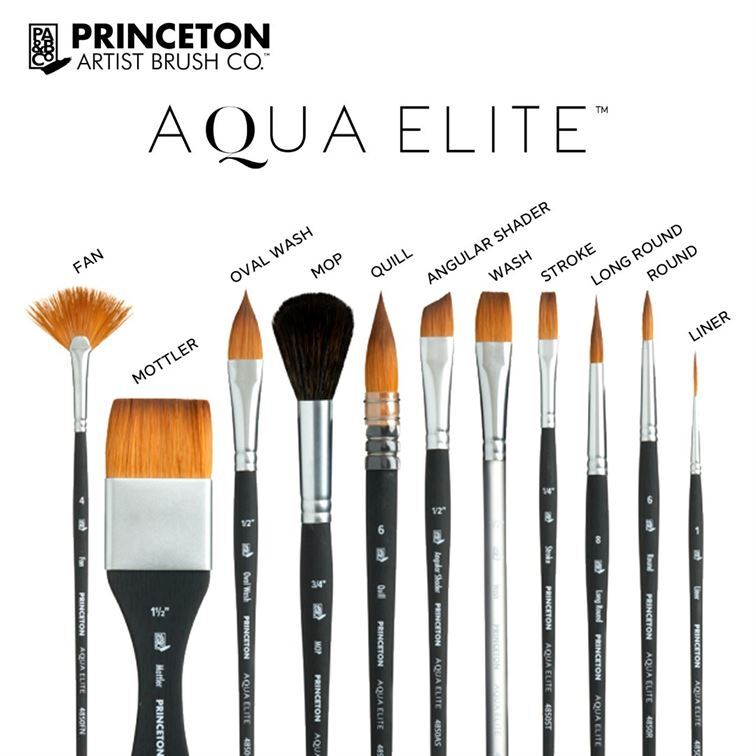Watercolour Brushes come in variety of shapes and sizes but also several diffent types of hair is used. in this brief we will give you an idea of the difference. Script liner, flat brush, round brush or filbert brush… Given the range of instruments available to you, it pays to know what is what, so lets start off with a small number of paintbrushes in different sizes and focus on quality. You can always add to your collection as you acquire more experience.
Overview:
- Paintbrush Shapes
- Natural or synthetic bristles
- Synthetic fibre Watercolour Brushes
- Anatomy of the paintbrush
Paintbrush Shapes
Are you just getting starting? Here are the essential Shapes for Watercolour Brushes
- The round paintbrush: an all-purpose brush for applying washes and drawing narrow lines. The indispensable round brushes will handle everything you need to do.
- The square flat brush: its flexibility allows you to draw precise lines and apply washes.
- The wash brush: it is both wide and flexible and can hold large amounts of water. It is ideal for spreading colour quickly over vast areas.
- The Mop brush: Mop Brushes or Quills have a longer hair, a finer point and a longer handle for that essential balance brush that holds a large amount of colour which should not leave hair behind on the paper.
Are you already painting? Consider these alternative shapes
- The oval brush is flat and tapered to a point, producing a characteristic stroke well suited to precision techniques and glazing.
- Fan-shaped brush: recommended for shading and blending techniques, and for dry brush work.
- The dagger brush: Its bristles are tapered to one; its main use is for drawing straight lines.
- The script liner brush: It holds significant amounts of paint and allows you to draw fine lines.
Natural or synthetic bristles?
Natural bristles
- Kolinsky Sable Brushes - very fine quality, particularly flexible, long-lasting and capable of holding large amounts of diluted paint … this is the watercolorist's paintbrush pinnacle of excellence.
- Squirrel hair Brushes is an exceptionally soft, absorbent hair that can hold paint exceptionally well and comes to an excellent point, perfect for mop and wash techniques, illustration, animation, rendering, dusting, fine lacquer.
- Brushes made from badger or goat can be less expensive and have their own role to play.

Synthetic fiber Watercolour Brushes
They are as fine and long-lasting as animal bristles, are generally firmer, and come in at the fraction of the price as the natural versions do. Synthetic brushes also offer a more humane offering to the natural version as no animals were harmed in the making of the brushes.
Taklon synthetic brushes - Usually made of a golden nylon often called Taklon. They are very similar in performance to natural brushes, holding plenty of water and are often described as having more ‘snap’. This means that the bristles bend when you press down onto the paper, but snap back into position when you lift the brush up. Many beginners find this easier to control and more cost effective.
Next Generation Synthetic Brushes - synthetic innovations by Princeton Brush co, have created brushes that are not only comparable to natural hair, but in some ways considered an improvement in durability, cost, shape and absorbency. Princeton leads the industry in the invention of new synthetic applications such as Neptune & Aqua Elite which behaves much like natural hair, and is equally responsive and more durable than the natural version.

Anatomy of the paintbrush
A paintbrush has the following features:
A. Bristles: whether they have synthetic fibers or natural bristles, they need to keep their shape when wet.
B. Bristles: they absorb paint and release it gradually.
C. Heel: this is the part where the fibers are inserted in the ferrule.
D. Ferrule: an actual metal collar that holds the handle and bristles together.
Art to Art is your one-stop shop for watercolour Brush supplies.




